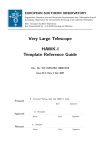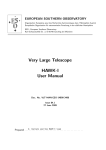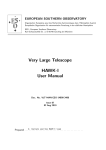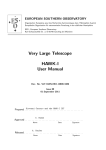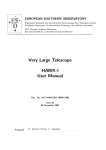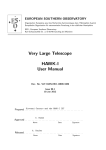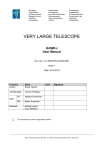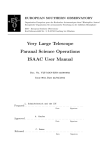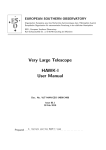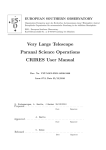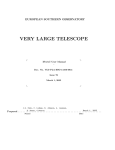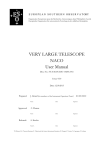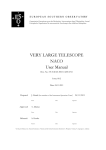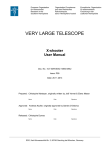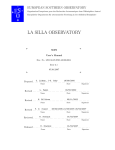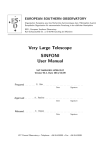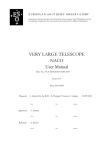Download HAWK-I Template Reference Guide
Transcript
EUROPEAN SOUTHERN OBSERVATORY Organisation Européene pour des Recherches Astronomiques dans l’Hémisphère Austral Europäische Organisation für astronomische Forschung in der südlichen Hemisphäre ESO - European Southern Observatory Karl-Schwarzschild Str. 2, D-85748 Garching bei München Very Large Telescope HAWK-I Template Reference Guide Doc. No. VLT-MAN-ESO-14800-4076 Issue 95, Date 27 August 2014 Prepared G. Carraro and the HAWK-I team . . . . . . . . . . . . . . . . . . . . . . . . . . . . . . . . . . . . . . . . . . Date Approved C. Dumas . . . . . . . . . . . . . . . . . . . . . . . . . . . . . . . . . . . . . . . . . . Name Released Signature Date Signature A. Kaufer . . . . . . . . . . . . . . . . . . . . . . . . . . . . . . . . . . . . . . . . . . Name Date Signature HAWK-I Template Reference Guide VLT-MAN-ESO-14800-4076 ii Change Record Issue/Rev. Date 1 2 3 81.0 81.1 83.0 84.0 84.1 86.0 88.0 91.0 92.0 94.0 95.0 Oct 26, 2004 Mar 23, 2007 Dec 03, 2007 Dec 23, 2007 Jan 8, 2008 Dec 19, 2008 May 29, 2009 Jun 26, 2009 Aug 02, 2010 Feb 07, 2011 Sep 06, 2012 Mar 01, 2013 Jun 14, 2014 Aug 27, 2014 Section/Parag. affected Reason/Initiation/Documents/Remarks all all all 1.3.2, 3.3, 4.2.4, 4.3.2, 4.3.4, 4.4.8 4.2.4 4.2.4 4.2.4 4.2.4 4.3 first version, prepared for FDR second version, prepared for coding and PAE P81 version for phase 2 Correction of mistakes exposures and offsets minimum DIT minimum DIT and minor modifications change of offset scheme inclusion of Fast Photometry templates no news no news no news fixed some bugs spotted by C. Dumas no news HAWK-I Template Reference Guide Contents VLT-MAN-ESO-14800-4076 iii HAWK-I Template Reference Guide 1 1.1 VLT-MAN-ESO-14800-4076 1 Introduction Purpose and Scope This document describes in some detail the observing, calibration and technical templates for HAWK-I. The tables and descriptions are based on the HAWK-I Instrument Package (IP) version 127.19. 1.2 Instrument Summary HAWK-I is a wide-field (7.50 × 7.50 ), NIR (0.9-2.5 µm) camera operating only in direct imaging mode. To completely define an exposure users have only to specify the target package, that is target RA, Dec, and EPOCH, plus non-sidereal motion rates if any, and the instrument configuration: filter and exposure parameters (DIT, NDIT, NEXPO, and NOFFSETS). 1.3 1.3.1 Applicable and reference documents Applicable documents none 1.3.2 Reference documents HUM HAWK-I User’s Manual VLT-MAN-ESO-14800-3486 RD-1 HAWK-I Calibration Plan VLT-PLA-ESO-14800-3214 P2PP P2PP User’s Guide VLT-MAN-ESO-19200-1644 1.4 Abbreviations and acronyms AD ADU AO BOB DCR DIT ESO ETC GSC HAWK-I NDIT NIR NDR OB OS OT P2PP RRM Applicable Document Analog-Digital Units Adaptive Optics Broker of Observation Blocks Double Correlated Read Detector Integration Time European Southern Observatory Exposure Time Calculator Guide Star Catalogue High Acuity Wide-field K-band Imager Number of DIT Near Infra-Red Non-Destructive Read Observing Block Observing Software Observing Tool Phase 2 Proposal Preparation tool Rapid Response Mode HAWK-I Template Reference Guide QE RD RON RTD UT Quantum Efficiency Reference Document Read Out Noise Real Time Display Unit Telescope, VLT 8m telescope VLT-MAN-ESO-14800-4076 2 HAWK-I Template Reference Guide 2 VLT-MAN-ESO-14800-4076 3 Instrument Modes and Configurations HAWK-I has only one (2) instrument mode: direct imaging and fast photometry. Only the two filter wheels and detector can be configured/set-up in the instrument. • Filters: 4 broad band, and 6 narrow band. • Detector: set-up of the exposure time: DIT, NDIT, NEXPO. 3 Template Overview This section provides a brief overview of the HAWK-I templates. Each template is described in more detail in the subsequent sections. 3.1 General remarks All scientific and calibration observations with ESO instruments are prepared by building observing blocks (OBs) as a sequence of the available templates for the specific instruments. This is performed with the help of the phase 2 proposal preparation tool (P2PP). The scheduling of these OBs is done on the site with P2PP in visitor mode, and with a special Observing Tool (OT) in service mode. The execution of the OBs is then done with the broker of observing blocks (BOB). It will be convenient while reading this manual to have a copy of the P2PP Manual available that can be found at http://www.eso.org/sci/observing/phase2/P2PPSurveys/P2PP3Documentation.html Observing blocks generally consist of an acquisition template, and a (small) number of user selected science or calibration templates. Notice that the target information is entered in what is called the Target package in the tabbed section located at the bottom of the P2PP tool window while the acquisition template describes ‘how” to acquire the target. In addition, service mode OBs contain the observing constraints set and the scheduling information which are entered in the same tabbed section of P2PP. The observing templates which are described below are lists of keywords (parameters of the respective templates) that define the configuration and setup to be used for the respective observations. Parameters are either available in P2PP for being set-up by the user, or they might be hidden from the user in P2PP (when the value is frozen to a default) in order to compact and to simplify the appearance of the parameter lists. Hidden parameters can not be changed by the users but could be modified in real time by the instrument operators. Since hidden parameters will be rarely changed during science observation runs, we might not provide an extensive explanation in the template reference section. 3.2 Acquisition and science templates Unlike for many other ESO instruments there are only a few templates available for HAWK-I. The instrument works in a single observing mode: imaging. The templates are listed below, together with the short description of the functionalities. HAWK-I Template Reference Guide VLT-MAN-ESO-14800-4076 4 The functionality of the acquisition and science templates is generally identical to the equivalent ISAAC (now decommisioned) SW imaging templates. Table 1: Acquisition and science HAWK-I templates acquisition templates HAWKI img acq Preset HAWKI img acq PresetRRM HAWKI img acq MoveToPixel HAWKI img acq MoveToPixelRRM HAWKI img acq FastPhot science templates HAWKI img obs AutoJitter HAWKI img obs AutoJitterOffset HAWKI img obs FixedSkyOffset HAWKI img obs GenericOffset HAWKI img obs FastPhot functionality Simple telescope preset Simple telescope preset Interactive target acquisition Interactive target acquisition Acquisition in windowed mode comment recommended for RRM observations imaging imaging imaging imaging imaging recommended for low-density fields recommended for extended objects when random sky is not suited with jitter (no offsets) with jitter and random sky offsets with jitter and fixed sky offsets with user defined offsets in windowed mode for RRM observations When HAWK-I will be upgraded to make use of the adaptive secondary UT mirror (in 2015), an AO acquisition template will be added, if its functionality cannot be merged into the regular acquisition templates. 3.3 Calibration and technical templates The calibration plan [RD-1] describes in more detail the procedure to acquire the calibration data required by the scientific observations. The currently available calibration and technical templates are the following: Table 2: Calibration and technical HAWK-I templates calibration templates HAWKI img cal Darks HAWKI img acq TwPreset HAWKI img cal TwFlats HAWKI img cal SkyFlats HAWKI img cal StandardStar technical templates HAWKI gen tec StandBy HAWKI img tec IlluFrame HAWKI img tec Astrometry HAWKI img tec Flexure HAWKI img tec DetTest HAWKI img tec DetLin HAWKI img tec FilterWheel functionality series of darks acquisition for flat-field imaging twilight flat-field imaging twilight flat-field imaging of standard field comment at zenith, no tracking at empty fields, tracking only set system to mode Standby imaging of illumination field imaging of astrometric field measuring instrument flexure/center of rotation detector test/monitoring detector linearity check filter wheel positioning accuracy The calibration templates are designed to obtain twilight flat-fields, dark frames, standard stars for all broad band filters (typically at the center of each detector). The technical templates are used to obtain illumination frames (by placing a standard star in several points of a regular grid on each detector), an astrometric/distortion solution (either by jittered images of a dense astrometric star cluster field, or the observation of a large astrometric field), and to characterize the detector. Two further technical templates are available to measure any flexure and misalignment with respect to the telescope optical axis (rotating the instrument while observing a stellar field), and to measure the positioning accuracy/reproducibility of the filter positioning. Other technical templates exist for instrument maintenance. HAWK-I Template Reference Guide 4 4.1 4.1.1 VLT-MAN-ESO-14800-4076 5 Template Description Acquisition Templates Introduction Telescope presets can only be done via acquisition templates. Telescope presets move the telescope to the requested coordinates and allow the telescope operator to select a telescope guide star and start the active optics. Additionally, these templates set up the detector and the instrument. Observation templates, on the other hand, only deal with telescope offsets, and not with telescope presets. The HAWKI img acq MoveToPixel acquisition template dumps an image to disk; the HAWKI img acq Preset template does not. These dumped images are aimed at keeping track of the field position and orientation before starting the observation, and are part of the images distributed to users. In general, it is not necessary for the acquisition and the subsequent observation templates to have the same DIT and NDIT. 4.1.2 HAWKI img acq Preset Table 3: Parameters of HAWKI img acq Preset HAWKI img acq Preset.tsf To be specified: Parameter DET.DIT DET.NDIT INS.FILT.NAME Hidden no no no SEQ.PRESET TEL.AG.GUIDESTAR yes no TEL.GS1.ALPHA TEL.GS1.DELTA TEL.ROT.OFFANGLE TEL.TARG.ADDVELALPHA TEL.TARG.ADDVELDELTA TEL.TARG.ALPHA TEL.TARG.DELTA TEL.TARG.EQUINOX TEL.TARG.NAME TEL.TARG.OFFSETALPHA TEL.TARG.OFFSETDELTA Fixed values: Parameter Label DIT (secs) NDIT Filter Name no no no yes yes no no no no no no Range (Default) 1.6762..3600 (NODEFAULT) 1..1000 (1) Ks H J Y BrG NB2090 CH4 NB1190 NB1060 H2 (NODEFAULT) T F (T) NONE SETUPFILE CATALOGUE (CATALOGUE) (0.0) (0.0) -360.0..360.0 (0) -100..100 (0) -100..100 (0) (NODEFAULT) (NODEFAULT) -2000..3000 (2000) (NODEFAULT) -999..999 (0.0) -999..999 (0.0) Hidden Value Label Preset telescope? Telescope Guide Star Selection RA of telescope guide star DEC of telescope guide star Position Angle on Sky (deg) Add Velocity Alpha Add Velocity Delta Equinox Name of the Target Alpha offset for the target (arcsec) Delta offset for the target (arcsec) This template does a simple telescope preset. It is the easiest template to use when objects can be easily identified against the sky background. It should not be used if the user wants a pointing accuracy that is better than few arcsec. The instrument parameters should be set to values used in the subsequent imaging template, in order to have the instrument already set-up for the start of the first science template. This will save time. In general, one should not put objects of interest at the very center of the array, as the four quadrants are spaced by ∼ 150 pixels. HAWK-I Template Reference Guide VLT-MAN-ESO-14800-4076 6 Table ?? describes the parameters of this template. No RTD image is dumped on disk at the end of this template. If TEL.AG.GUIDESTAR is set to CATALOGUE, then the guide star selection is left to the telescope operator who will interactively identify a suitable guide star from the GSC2 (in which case the keywords TEL.GS1.ALPHA and TEL.GS1.DELTA will be ignored). If TEL.AG.GUIDESTAR is set to SETUPFILE then the user has to specify the guide star by providing its coordinates in the keywords TEL.GS1.ALPHA and TEL.GS1.DELTA. 4.1.3 HAWKI img acq PresetRRM Table 4: Parameters of HAWKI img acq PresetRRM HAWKI img acq PresetRRM.tsf To be specified: Parameter DET.DIT DET.NDIT INS.FILT.NAME Hidden no no no SEQ.PRESET SEQ.RRM.REGISTER SEQ.RRM.VISITOR TEL.AG.GUIDESTAR yes yes no no TEL.GS1.ALPHA TEL.GS1.DELTA TEL.ROT.OFFANGLE TEL.TARG.ADDVELALPHA TEL.TARG.ADDVELDELTA TEL.TARG.ALPHA TEL.TARG.DELTA TEL.TARG.EQUINOX TEL.TARG.NAME TEL.TARG.OFFSETALPHA TEL.TARG.OFFSETDELTA Fixed values: Parameter DPR.CATG DPR.TECH DPR.TYPE Label DIT (secs) NDIT Filter Name no no no yes yes no no no no no no Range (Default) 1.6762..3600 (NODEFAULT) 1..1000 (1) Ks H J Y BrG NB2090 CH4 NB1190 NB1060 H2 (NODEFAULT) T F (T) F T (T) F T (F) NONE SETUPFILE CATALOGUE (CATALOGUE) (0.0) (0.0) -360.0..360.0 (0) -100..100 (0) -100..100 (0) (NODEFAULT) (NODEFAULT) -2000..3000 (2000) (NODEFAULT) -999..999 (0.0) -999..999 (0.0) Hidden yes yes yes Value ACQUISITION IMAGE OBJECT Label Data product category Data product technique Data product type Preset telescope? Register OB in RRM system Allow RRM activation in VISITOR mode Telescope Guide Star Selection RA of telescope guide star DEC of telescope guide star Position Angle on Sky (deg) Add Velocity Alpha Add Velocity Delta Equinox Name of the Target Alpha offset for the target (arcsec) Delta offset for the target (arcsec) This template is functionally identical to HAWKI img acq Preset apart from having a few more parameters (see Table ??) and it is intended for acquisition of RRM imaging OBs. HAWK-I Template Reference Guide 4.1.4 VLT-MAN-ESO-14800-4076 7 HAWKI img acq MoveToPixel Table 5: Parameters of HAWKI img acq MoveToPixel HAWKI img acq MoveToPixel.tsf To be specified: Parameter DET.DIT DET.NDIT INS.FILT.NAME Hidden no no no SEQ.PRESET SEQ.SKYFLAT SEQ.SKYOFFSET.ALPHA SEQ.SKYOFFSET.DELTA TEL.AG.GUIDESTAR yes no no no no TEL.GS1.ALPHA TEL.GS1.DELTA TEL.ROT.OFFANGLE TEL.TARG.ADDVELALPHA TEL.TARG.ADDVELDELTA TEL.TARG.ALPHA TEL.TARG.DELTA TEL.TARG.EQUINOX TEL.TARG.NAME Fixed values: Parameter DPR.CATG DPR.TECH DPR.TYPE Label DIT (secs) NDIT Filter Name no no no yes yes no no no no Range (Default) 1.6762..3600 (NODEFAULT) 1..1000 (1) Ks H J Y BrG NB2090 CH4 NB1190 NB1060 H2 (NODEFAULT) T F (T) T F (T) (10) (10) NONE SETUPFILE CATALOGUE (CATALOGUE) (0.0) (0.0) -360.0..360.0 (0) -100..100 (0) -100..100 (0) (NODEFAULT) (NODEFAULT) -2000..3000 (2000) (NODEFAULT) Hidden yes yes yes Value ACQUISITION IMAGE OBJECT Label Data product category Data product technique Data product type Preset telescope? Take initial sky frame? RA offset to sky DEC offset to sky Telescope Guide Star Selection RA of telescope guide star DEC of telescope guide star Position Angle on Sky (deg) Add Velocity Alpha Add Velocity Delta Equinox Name of the Target This template presets the telescope and allows the operator to interactively center the field. In visitor mode, the interactive part of the template will be executed by the instrument operator under the supervision of the visiting astronomer. In service mode, it is mandatory that users send detailed information, including finding charts, for the field centering. It should be used when very precise, e.g. <∼ 2 − 300 , centering of the field is required; or to move a bright star to one of the gaps1 , etc. In general, one should not put objects of interest at the very center of the array, as the four quadrants are spaced by ∼ 150 pixels. At the beginning of the template one fixed pattern image is acquired in an offset position defined by the SEQ.SKYOFFSET.ALPHA and SEQ.SKYOFFSET.DELTA parameters. The RTD is then set up to subtract this fixed pattern from all subsequently displayed images. The integration time for the acquisition images is defined by the DIT and NDIT parameters. After the first target image is acquired, the observer can change DIT and NDIT interactively. In the case of a fixed pattern: if DIT and/or NDIT are changed, the telescope offsets again and the observer is given the option to store another fixed pattern before the telescope returns to the nominal position. This loop can continue until the user has identified the target. Once the observer is satisfied with the acquisition image, he/she is prompted for an offset to center the target. This is done interactively by drawing an arrow on the screen with the left hand button of the mouse. At this point a window, which lists the pixel co-ordinates at the start and the end of the arrow, will appear. The user can either accept the offsets, cancel, or edit the co-ordinates directly. If the offsets are accepted, the telescope offsets by the desired amount and a new image 1 The user nevertheless must check in the HAWKI User’s Manual for the maximum brightness allowed, as this template can not be used if the bright star violates those limits. HAWK-I Template Reference Guide VLT-MAN-ESO-14800-4076 8 is acquired. The user is given the possibility to refine the position if necessary. Once the user is satisfied, the template finishes. If the parameter “SEQ.PRESET” is set to “F”, then the telescope will not move. This can be useful in visitor mode to use the functionality of the template (setting-up the instrument, checking/refining the position) without having to fully preset the telescope again, and thus saving a little time. N.B.: the interactive pop-up windows are usually displayed before new images have arrived on the RTD. Therefore, users are strongly advised to carefully check that a new image has arrived before clicking on these windows (e.g. for storing a fixed pattern, for changing the DIT and NDIT). The image displayed on RTD at the end of the template is saved to disk. See Table 5 for details. 4.1.5 HAWKI img acq MoveToPixelRRM An identical version for RRM observations is available (see Table‘6): Table 6: Parameters of HAWKI img acq MoveToPixelRRM HAWKI img acq MoveToPixelRRM.tsf To be specified: Parameter DET.DIT DET.NDIT INS.FILT.NAME Hidden no no no SEQ.PRESET SEQ.RRM.REGISTER SEQ.RRM.VISITOR SEQ.SKYFLAT SEQ.SKYOFFSET.ALPHA SEQ.SKYOFFSET.DELTA TEL.AG.GUIDESTAR yes yes no no no no no TEL.GS1.ALPHA TEL.GS1.DELTA TEL.ROT.OFFANGLE TEL.TARG.ADDVELALPHA TEL.TARG.ADDVELDELTA TEL.TARG.ALPHA TEL.TARG.DELTA TEL.TARG.EQUINOX TEL.TARG.NAME Fixed values: Parameter DPR.CATG DPR.TECH DPR.TYPE Label DIT (secs) NDIT Filter Name no no no yes yes no no no no Range (Default) 1.6762..3600 (NODEFAULT) 1..1000 (1) Ks H J Y BrG NB2090 CH4 NB1190 NB1060 H2 (NODEFAULT) T F (T) F T (T) F T (F) T F (T) (10) (10) NONE SETUPFILE CATALOGUE (CATALOGUE) (0.0) (0.0) -360.0..360.0 (0) -100..100 (0) -100..100 (0) (NODEFAULT) (NODEFAULT) -2000..3000 (2000) (NODEFAULT) Hidden yes yes yes Value ACQUISITION IMAGE OBJECT Label Data product category Data product technique Data product type Preset telescope? Register OB in RRM system Allow RRM activation in VISITOR mode Take initial sky frame? RA offset to sky DEC offset to sky Telescope Guide Star Selection RA of telescope guide star DEC of telescope guide star Position Angle on Sky (deg) Add Velocity Alpha Add Velocity Delta Equinox Name of the Target HAWK-I Template Reference Guide 4.1.6 VLT-MAN-ESO-14800-4076 9 Fast Photometry Acquisition template Table 7: Parameters of Fast Photometry Acquisition template HAWKI img acq FastPhot.tsf To be specified: Parameter DET.DIT DET.NDIT INS.FILT.NAME Hidden no no no SEQ.BADAG SEQ.BADAO SEQ.PRESET SEQ.SKYFLAT SEQ.SKYOFFSET.ALPHA SEQ.SKYOFFSET.DELTA SEQ.WIN.NX yes yes yes no no no no SEQ.WIN.NY SEQ.WIN.STARTX SEQ.WIN.STARTY TEL.AG.GUIDESTAR no no no no TEL.GS1.ALPHA TEL.GS1.DELTA TEL.ROT.OFFANGLE TEL.TARG.ADDVELALPHA TEL.TARG.ADDVELDELTA TEL.TARG.ALPHA TEL.TARG.DELTA TEL.TARG.EQUINOX TEL.TARG.NAME Fixed values: Parameter DPR.CATG DPR.TECH DPR.TYPE TEL.TARG.OFFSETALPHA TEL.TARG.OFFSETDELTA no no no yes yes no no no no 0..2048 (2048) 1..127 (1) 1..2047 (1) NONE SETUPFILE (CATALOGUE) (0.0) (0.0) -360.0..360.0 (0) -100..100 (0) -100..100 (0) (NODEFAULT) (NODEFAULT) -2000..3000 (2000) (NODEFAULT) Hidden yes yes yes no no Value ACQUISITION IMAGE OBJECT 0.0 0.0 Range (Default) 0.001..3600 (NODEFAULT) 1..1000 (1) Ks H J Y BrG NB2090 CH4 NB1190 NB1060 H2 (NODEFAULT) T F (F) T F (F) T F (T) T F (T) (10) (10) 0..128 (128) CATALOGUE Label DIT (secs) NDIT Filter Name Ignore AG Ignore AO Preset telescope? Take initial sky frame? RA offset to sky DEC offset to sky Number of columns for each window stripe Number of rows for each window stripe First column of window within a stripe First row of window within a stripe Telescope Guide Star Selection RA of telescope guide star DEC of telescope guide star Position Angle on Sky (deg) Add Velocity Alpha Add Velocity Delta Equinox Name of the Target Label Data product category Data product technique Data product type Alpha offset for the target (arcsec) Delta offset for the target (arcsec) This is the acquisition template for the recently (as of P86) offered Fast Photometry mode. It is described in details in the User Manual. Table 7 summarises its properties. HAWK-I Template Reference Guide 4.2 VLT-MAN-ESO-14800-4076 10 Science Templates The four science observing templates provide various strategies for the nodding between object and sky positions and for the jitter offsets between the images taken at the selected object and sky positions. The most simple and recommended templates are AutoJitter and AutoJitterOffset. AutoJitter will automatically take exposures in an AAAA sequence, where A refers to the OBJECT position. The GenericOffset template allows to specify any sequence of object and sky positions. The FixedSkyOffset also automatically takes exposures in an ABBA sequence with positions jittered with respect to each other, but nods to a fixed, user-defined, sky position. The respective A (object) positions are randomly jittered with respect to each other, and so are the respective B (sky) positions. FixedSkyOffset will take an ABBA. . . or an BAAB. . . sequence depending on whether SEQ.OBSTYPE is set to O or S respectively. The common parameters to these templates are described here: DET.DIT and DET.NDIT: are the user defined detector integration time (DIT) (for all exposures: target and sky) and the number of DITs (NDIT) to be averaged 2 by the electronics before the frame is written to disk. While the DIT is common to both object and sky, NDIT can be set independently for object and sky for all templates that move to a sky position. Number of exposures per offset, SEQ.NEXPO: defines the number of exposures to be taken at each offset position. It can be set to values different from one (1) in the cases where more than one exposure shall be taken at each (on/off) position before nodding to the next (on/off) offset position. For typical applications, it remains set to one (e.g for classical ABBA sequences). Number of AB or BA cycles, SEQ.NABCYCLES: defines how often the AB cycle is repeated. If set to one, the template will take a simple AB sequence (one offset). If set to two, it will take a ABBA (object, sky, sky, object) sequence. If set to three, it will take a ABBAAB sequence, an so on. For best sky subtraction, the number of cycles should be set to a value of two or larger. Number of offset positions, SEQ.NOFFSET: the above number of AB cycles is replaced in the AutoJitter and GenericOffset template by the number of offset positions, NOFFSET. In the AutoJitter template, the offsets are determined randomly within a box. In the GenericOffset template, the offset positions are defined by the OFFSET1 and OFFSET2 lists. Typically, both lists will have the same length, if not, the shortest list (and maybe even the longest list) will repeat itself until NOFFSET frames have been obtained. SEQ.FC.ST: This keyword controls whether to use software flexure compensation. During commisioning it was found that flexures were negligible so that the parameter is hidden and has the default value of “F” for all templates. SEQ.FILEID: This parameter determine the string to be attached to the file names of the images in the instrument workstation. It is hidden so it can not be set by the user, it can only be set by the operator at Paranal. 2 Note that the frames will contain the average of the NDIT exposures, NOT a sum, a fact that has to be kept in mind by the user when reducing the data. HAWK-I Template Reference Guide VLT-MAN-ESO-14800-4076 11 SEQ.SHOW.GRAPH: This hidden parameter controls, at execution time, whether to display a utility window that shows the offsets that will be requested by the template. It keeps track of which offsets have been observed, and the current observation offset. DET.SATLEVEL: This keyword controls the reading mode of the HAWAII 2RG arrays. It is defined as 60% (25,000 counts) of the detector full well. SEQ.CATG: This keyword can be either SCIENCE or TECH, but for normal operation must be set only as SCIENCE. Note that for all science templates, if the template is aborted, the telescope will return to origin (i.e. the position on sky at the beginning of the template, before any offset was performed). 4.2.1 HAWKI img obs AutoJitter Table 8: Parameters of HAWKI img obs AutoJitter HAWKI img obs AutoJitter.tsf To be specified: Parameter DET.DIT DET.NDIT DET.SATLEVEL INS.FILT.NAME SEQ.CATG SEQ.FC.ST SEQ.FILEID SEQ.JITTER.WIDTH SEQ.NEXPO SEQ.NOFFSET SEQ.POISSON SEQ.RETURN SEQ.SHOW.GRAPH Fixed values: Parameter DPR.CATG DPR.TECH DPR.TYPE Hidden no no no no Label DIT (secs) NDIT SATLEVEL Filter Name no yes yes no no no yes no yes Range (Default) 1.6762..3600 (NODEFAULT) 1..1000 (1) -32768..40000 (25000) Ks H J Y BrG NB2090 CH4 NB1190 NB1060 H2 (NODEFAULT) TECHNICAL SCIENCE (SCIENCE) T F (F) (AutoJitter) 5..60 (NODEFAULT) 1..1000 (NODEFAULT) 1..1000 (NODEFAULT) 1..100 (10) T F (T) T F (T) Hidden yes yes yes Value SCIENCE IMAGE OBJECT Label Data product category Data product technique Data product type Observation Category Use flexure compensation? Filename id Jitter Box Width (arcsec) Number of exposures per offset Number of offsets within a box Random throw generator Return to origin? Show quick-look graphics? This template offsets the telescope between exposures according to a random pattern of offsets automatically determined within the template. It is ideal for long integrations on sparcely populated fields, and does not require a long list of offsets to be defined. The offsets are distributed randomly within a box whose size is defined by the parameter SEQ.JITTER.WIDTH (in arc seconds), with the condition that the distance between any two points in a series of ten values (note SEQ.POISSON) is greater than a certain minimum. This is intentionally done to ensure that the 5 frames before and after any frame are spatially not too close and can be safely used for creating sky frames without residual objects for sky subtraction3 . 3 The hidden SEQ.POISSON parameter plays a dual role here (note that it is not the seed for the random number generator). In the first place it gives the number of contiguous frames that will satisfy a minimum distance constraint, that is, the distance between any pair in the set of contiguous frames will be at least dmin . It is also HAWK-I Template Reference Guide VLT-MAN-ESO-14800-4076 12 Figure 1: Illustration of the HAWKI img obs AutoJitter template. The black dots represent the position of a star, which was originally at the center of the field. The value of the SEQ.JITTER.WIDTH parameter corresponds to the full width of the square box in which the offsets are generated. Defining too wide a box may lead to poor image overlap. Conversely, too small a value may lead to poor sky subtraction near extended objects. A value of ∼ 30 arcsec or less is adequate for sparcely populated stellar fields. The minimum value is set to 5 arcsec. Note also that the mosaic gap is approximately 1500 , so to ensure that all points on sky are sampled by a minimum number of observation the user should choose the SEQ.JITTER.WIDTH and the SEQ.NOFFSET parameters appropriately. By construction, there is no telescope offset before the first exposure. The parameters for this template are summarised in Table 8, and illustrated in Fig. 1. The total integration time (excluding overheads) is defined, in seconds, by: DIT × NDIT × NEXPO× NOFFSET used, together with the dimensions of the jitter box Sx and Sy, in the definition of dmin : s Sx × Sy √ dmin = SEQ.POISSON 2. For more detail see Devillard (1999; ASP 172, 333). HAWK-I Template Reference Guide 4.2.2 VLT-MAN-ESO-14800-4076 13 HAWKI img obs AutoJitterOffset Table 9: Parameters of HAWKI img obs AutoJitterOffset HAWKI img obs AutoJitterOffset.tsf To be specified: Parameter DET.DIT DET.SATLEVEL INS.FILT.NAME SEQ.CATG SEQ.FC.ST SEQ.FILEID SEQ.JITTER.WIDTH SEQ.NABCYCLES SEQ.NDIT.OBJECT SEQ.NDIT.SKY SEQ.NEXPO SEQ.OFFS2B SEQ.POISSON SEQ.RETURN SEQ.SHOW.GRAPH SEQ.SKYTHROW Fixed values: Parameter DPR.CATG DPR.TECH Hidden no no no Label DIT (secs) SATLEVEL Filter Name no yes yes no no no no no yes yes no yes no Range (Default) 1.6762..3600 (NODEFAULT) -32768..40000 (25000) Ks H J Y BrG NB2090 CH4 NB1190 NB1060 H2 (NODEFAULT) TECHNICAL SCIENCE (SCIENCE) T F (F) (AutoJitterOffset) 5..60 (NODEFAULT) 0..100 (NODEFAULT) 1..1000 (1) 1..1000 (1) 1..1000 (NODEFAULT) 0..100 (3) 1..100 (10) T F (T) T F (T) 0..1800 (NODEFAULT) Hidden yes yes Value SCIENCE IMAGE Label Data product category Data product technique Observation Category Use flexure compensation? Filename id Jitter Box Width (arcsec) Number of AB or BA cycles NDIT on OBJECT positions NDIT on SKY positions Number of exposures per offset Constant offset for 2’nd B Random throw generator Return to origin? Show quick-look graphics? Sky Offset Throw Figure 2 illustrates what the template does, and Table 9 list the involved parameters. This template moves the telescope alternatively between ‘object’ and ‘sky’ positions. The ‘object’ positions of the telescope are randomly distributed around the object (initial telescope position) and within a box whose dimensions are set by the parameter SEQ.JITTER.WIDTH (in arcsec). The minimum value for this parameter is 5 arcsec. By default, there is no random jitter offset before the first exposure. The ‘sky’ positions are at a constant distance (defined by the parameter Sky Offset Throw) from the original telescope position, but at an angle randomly distributed between 0 and 360 degrees (i.e. the ‘sky’ exposures are distributed on a circle surrounding the initial telescope position). The Number of AB or BA cycles defines the number of OBJECT-SKY (AB), or SKY-OBJECT (BA) cycles to be executed. These cycles are executed in ABBA sequences. E.g. if Number of AB or BA cycles is set to 3, 6 exposures will be taken in an ABBAAB sequence. Notice that in the part of the cycle where two Bs are next to each other it is necessary to offset the second sky field from the first. The offset for this second frame is determined by the keyword SEQ.OFFS2B, the telescope is offseted to the NE or SW depending on the sign of the value entered by an amount equal to SEQ.OFFS2B. In addition, the template provides the flexibility to adjust the number of subintegrations (NDIT) separately for OBJECT and SKY frames. SEQ.NDIT.OBJECT defines the number of subintegrations on the object, and SEQ.NDIT.SKY defines the number of subintegrations on the sky. The total integration time (excluding overheads) is defined, in seconds, by: DIT × (SEQ.NDIT.OBJECT + SEQ.NDIT.SKY) × SEQ.NEXPO×SEQ.NABCYCLES. Thus, the total integration time on the sky and on the object can be adjusted so that the S/N on the object is optimised. Remember that the “1 minute per telescope position rule” here means that both (DIT×SEQ.NDIT.OBJECT×NEXPO) and (DIT×SEQ.NDIT.SKY×NEXPO) shall both exceed one minute of time. HAWK-I Template Reference Guide VLT-MAN-ESO-14800-4076 14 Figure 2: Illustration of the HAWKI img obs AutoJitterOffset template. The black dots in the central square represent the position of a star, which was originally at the center of the field. The other squares represent the position of the SKY frames. HAWK-I Template Reference Guide 4.2.3 VLT-MAN-ESO-14800-4076 15 HAWKI img obs FixedSkyOffset Table 10: Parameters of HAWKI img obs FixedSkyOffset HAWKI img obs FixedSkyOffset.tsf To be specified: Parameter DET.DIT DET.SATLEVEL INS.FILT.NAME SEQ.CATG SEQ.FC.ST SEQ.FILEID SEQ.JITTER.WIDTH SEQ.NABCYCLES SEQ.NDIT.OBJECT SEQ.NDIT.SKY SEQ.NEXPO SEQ.OBSTYPE SEQ.OFFSET.COORDS SEQ.POISSON SEQ.RETURN SEQ.SHOW.GRAPH SEQ.SKYOFFSET.ALPHA SEQ.SKYOFFSET.DELTA Fixed values: Parameter DPR.CATG DPR.TECH Hidden no no no Label DIT (secs) SATLEVEL Filter Name no yes yes no no no no no no yes yes no yes no no Range (Default) 1.6762..3600 (NODEFAULT) -32768..40000 (25000) Ks H J Y BrG NB2090 CH4 NB1190 NB1060 H2 (NODEFAULT) TECHNICAL SCIENCE (SCIENCE) T F (F) (FixedSkyOffset) 5..60 (NODEFAULT) 0..100 (NODEFAULT) 1..1000 (1) 1..1000 (1) 1..1000 (NODEFAULT) O S (O) SKY DETECTOR (SKY) 1..100 (10) T F (T) T F (T) (10) (10) Hidden yes yes Value SCIENCE IMAGE Label Data product category Data product technique Observation Category Use flexure compensation? Filename id Jitter Box Width (arcsec) Number of AB or BA cycles NDIT on OBJECT positions NDIT on SKY positions Number of exposures per offset Type of first observation Offset coordinate type selection Random throw generator Return to origin? Show quick-look graphics? RA offset to sky DEC offset to sky This template moves the telescope alternatively between ‘object’ and ‘sky’ positions. The ‘object’ positions of the telescope are randomly distributed around the object (initial telescope position) and within a box whose dimensions are set by the parameter SEQ.JITTER.WIDTH (in arcsec). The minimum value for this parameter is 5 arcsec. The involved parameters are summarised in Table 10, while an illustration of what the template does in presented in Fig. 3. The ‘sky’ positions are also randomly distributed around a fixed offset position (defined by the parameters SEQ.SKYOFFSET.ALPHA and SEQ.SKYOFFSET.DELTA) from the original (object) telescope position. The box dimensions of the random ’sky’ positions are set by the parameter SEQ.JITTER.WIDTH (i.e. the ‘sky’ exposures are distributed in a box offset from the initial telescope position). By default, there is no random jitter offset before the first exposure. The template allow the user to specify whether the starting observation will be on the object or on the sky, this is done with the keyword SEQ.OBSTYPE which should contain the type of the first observation. The Number of AB or BA cycles defines the number of OBJECT-SKY or SKY-OBJECT cycles to be executed.These cycles are executed in ABBA sequences. E.g. if SEQ.NABCYCLES is set to 3, then 6 exposures will be taken in an ABBAAB sequence. In addition, the template provides the flexibility to set independently the number of NDIT subintegrations for the OBJECT and SKY frames. SEQ.NDIT.OBJECT defines the number of subintegrations on the object, and SEQ.NDIT.SKY defines the number of subintegrations on the sky. The total integration time (excluding overheads) is defined, in seconds, by: DIT × (SEQ.NDIT.OBJECT+ SEQ.NDIT.SKY)×NEXPO×(SEQ.NABCYCLES). Thus, the total integration time on the sky and on the object can be adjusted so that the S/N on the object is optimised. Remember that the “1 minute per telescope position rule” her means that HAWK-I Template Reference Guide VLT-MAN-ESO-14800-4076 16 Figure 3: Illustration of the HAWKI img obs FixedSkyOffset template. The black dots in the central square represent the position of a star, which was originally at the center of the field. The other square represents the mean position of the SKY frames. both (DIT×SEQ.NDIT.OBJECT×NEXPO) and (DIT×SEQ.NDIT.SKY×NEXPO) shall both exceed one minute of time. 4.2.4 HAWKI img obs GenericOffset This template has the flexibility to do any sequence of telescope offsets, either in detector or sky coordinates. It is one of the most widely used templates (see Table 11). Telescope offsets are defined as lists with the parameters SEQ.OFFSET1.LIST and SEQ.OFFSET2.LIST. The offsets are relative to the previous position4 , in RA and DEC or in X and Y depending on the SEQ.OFFSET.COORDS parameter, and they are defined in arcsec. Fig . 4 and 5 show how it works. Additionally, the observation type can be defined for each image, and is entered as a list in the parameter SEQ.OBSTYPE.LIST. O stands for Object and assigns the DPR.CATG header keyword to SCIENCE. S stands for Sky and assigns the DPR.CATG header keyword to SKY. The number of exposures per offset is defined in the parameter SEQ.NEXPO. The number of offsets to be performed is determined by SEQ.NOFFSET, it can be different from the number of elements in the aforementioned (offset) lists. Lists do not need to have the same length. If the number of offsets is larger than the number of elements in a list, the list is restarted from the beginning as many times as needed until the correct number of frames have been acquired. The lists can have any length; however, having lists of different lengths can become extremely confusing. It is good practice to use lists of equal length or lists with only one value if one 4 Note that now in this HAWK-I does not differ anymore from the other ESO instruments HAWK-I Template Reference Guide VLT-MAN-ESO-14800-4076 17 Table 11: Parameters of HAWKI img obs GenericOffset HAWKI img obs GenericOffset.tsf To be specified: Parameter DET.DIT DET.SATLEVEL INS.FILT.NAME SEQ.CATG SEQ.FC.ST SEQ.FILEID SEQ.NDIT.LIST SEQ.NEXPO SEQ.NOFFSET SEQ.OBSTYPE.LIST SEQ.OFFSET.COORDS SEQ.OFFSET1.LIST SEQ.OFFSET2.LIST SEQ.RETURN SEQ.SHOW.GRAPH Fixed values: Parameter DPR.CATG DPR.TECH Hidden no no no Label DIT (secs) SATLEVEL Filter Name no yes yes no no no no no no no no yes Range (Default) 1.6762..3600 (NODEFAULT) -32768..40000 (25000) Ks H J Y BrG NB2090 CH4 NB1190 NB1060 H2 (NODEFAULT) TECHNICAL SCIENCE (SCIENCE) T F (F) (GenericOffset) (NODEFAULT) 1..1000 (NODEFAULT) 1..1000 (NODEFAULT) O S (NODEFAULT) SKY DETECTOR (DETECTOR) -600..600 (NODEFAULT) -600..600 (NODEFAULT) T F (T) T F (T) Hidden yes yes Value SCIENCE IMAGE Label Data product category Data product technique Observation Category Use flexure compensation? Filename id List of NDITs Number of exposures per offset Number of offsets Observation type list, O/S Offset coordinate type selection List of X or RA offsets (arcsec) List of Y or DEC offsets (arcsec) Return to origin? Show quick-look graphics? parameter is not changed. The total number of images taken by this template is SEQ.NEXPO× SEQ.NOFFSET. At the end of the template, the telescope is returned to the original position if the parameter SEQ.RETURN is set to true (T). If not, the telescope is not moved at the end of the template. The total integration time is defined, in seconds, by: DIT × NEXPO × NOFFSET X NDIT(i) 1 where NDIT(i) are the elements of the List of NDIT. 4.2.5 Fast Photometry template This template is used for windowed observations, and it is described in detailed in the user manual. It is offered only in BURST mode, both for service and visitor operations. HAWK-I Template Reference Guide VLT-MAN-ESO-14800-4076 18 Figure 4: Illustration of the HAWKI img obs GenericOffset template. The black dots represent the position of a star, which was originally at the center of the field. In this example, SEQ.OFFSET.COORDS is set to DETECTOR, and the the telescope is moved in X and Y according to the list of offsets. Figure 5: Illustration of the HAWKI img obs GenericOffset template. The black dots represent the position of a star, which was originally at the center of the field. In this example, SEQ.OFFSET.COORDS is set to SKY, and the telescope is moved in RA and DEC according to the list of offsets (the stars move in the opposite direction). HAWK-I Template Reference Guide VLT-MAN-ESO-14800-4076 19 Table 12: Parameters of Fast Photometry template HAWKI img obs FastPhot.tsf To be specified: Parameter DET.BURST.MODE DET.DIT DET.NCORRS.NAME Hidden no no yes DET.NDIT DET.NDITSKIP DET.NDSKIP DET.SATLEVEL INS.FILT.NAME no yes yes no no SEQ.BADAG SEQ.BADAO SEQ.CATG SEQ.EVENT.DATE SEQ.EVENT.TIME SEQ.FILEID SEQ.JITTER.WIDTH SEQ.NEXPO SEQ.NOFFSET SEQ.POISSON SEQ.RETURN SEQ.SHOW.GRAPH Fixed values: Parameter DPR.TECH DPR.TYPE Label Toggle Burst Mode DIT (secs) Non-destructive sampling readout mode name NDIT DITs to skip Samples skipped per DIT SATLEVEL Filter Name yes yes no no no yes no no no yes no yes Range (Default) F T (T) 0.001..3600 (NODEFAULT) NonDest NonDestNsamp Fowler FowlerNsamp (NonDest) 1..1000 (1) 0 (0) 0 (0) -32768..40000 (25000) Ks H J Y BrG NB2090 CH4 NB1190 NB1060 H2 (NODEFAULT) T F (F) T F (F) TECHNICAL SCIENCE (SCIENCE) (0) (0) (FAST) 0..60 (NODEFAULT) 1..1000 (NODEFAULT) 1..1000 (NODEFAULT) 1..100 (10) T F (T) T F (T) Hidden yes yes Value IMAGE OBJECT Label Data product technique Data product type Ignore AG Ignore AO Observation Category Absolute date of future event Absolute time of future event Filename id Jitter Box Width (arcsec) Number of exposures per offset Number of offsets within a box Random throw generator Return to origin? Show quick-look graphics? HAWK-I Template Reference Guide VLT-MAN-ESO-14800-4076 . This page has been left empty intentionally. 20 HAWK-I Template Reference Guide 4.3 VLT-MAN-ESO-14800-4076 21 Calibration Templates With the exception of the StandardStar one, these templates are only available to the users on the mountain. They are used by the staff at Paranal to carry out the short amd medium term calibrations of the instruments. A more detailed description of their utility can be found in [RD-1]. 4.3.1 HAWKI img cal Darks Table 13: Parameters of HAWKI img cal Darks HAWKI img cal Darks.tsf To be specified: Parameter SEQ.DIT.LIST SEQ.FILEID SEQ.NDIT.LIST SEQ.NEXPO Fixed values: Parameter DET.WIN.NX DET.WIN.NY DET.WIN.STARTX DET.WIN.STARTY DPR.CATG DPR.TECH DPR.TYPE Hidden no yes no no Range (Default) (NODEFAULT) (Darks) (NODEFAULT) 1..1000 (1) Label List of DITs Filename id List of NDITs NEXPO per DIT in list Hidden yes yes yes yes yes yes yes Value 0 0 1 1 CALIB IMAGE DARK Label Number of columns Number of rows First column of window First row of window Data product category Data product technique Data product type This template (see Table 13) acquires a number NEXPO of darks with specified DIT and NDIT (which should correspond to the DIT and NDIT of the exposure to correct for). 4.3.2 HAWKI img cal TwFlats Table 14: Parameters of HAWKI img cal TwFlats HAWKI img cal TwFlats.tsf To be specified: Parameter SEQ.DIT.ADJUST SEQ.DIT.LIST SEQ.FILEID SEQ.FILT.LIST SEQ.NCYCLES SEQ.NDIT.LIST SEQ.NEXPO Fixed values: Parameter DPR.CATG DPR.TECH DPR.TYPE Hidden no no yes no no no no Range (Default) T F (T) (NODEFAULT) (TwFlats) (NODEFAULT) 1..100 (10) (NODEFAULT) 1..1000 (1) Label Adjust DIT? List of DITs Filename id Filter List Number of cycles List of NDITs Number of exposures Hidden yes yes yes Value CALIB IMAGE FLAT Label Data product category Data product technique Data product type This template (see Table 14) is the one currently used to obtain twilight flat frames for HAWK-I, with the telescope at zenith (and without tracking). It is typically started up to one hour before sunset if red narrow-band flat-field are needed. The template cycles through a series of filters to determine the best DIT and NDIT to obtain a high initial count level on the frames (i.e. ∼ 25000 HAWK-I Template Reference Guide VLT-MAN-ESO-14800-4076 22 ADUs). After this, exposures are taken cycling through the filters obtaining frames with fixed DIT and NDIT (and decreasing count levels). The pipeline processes the series of frames doing a linear regression for the count levels of each pixel versus the average count level of the frame. An image containing for each pixel the slope of the regression is the “flat field” frame. 4.3.3 HAWKI img acq TwPreset Table 15: Parameters of HAWKI img acq TwPreset HAWKI img acq TwPreset.tsf To be specified: Parameter DET.DIT DET.NDIT INS.FILT.NAME SEQ.PRESET TEL.AG.GUIDESTAR TEL.GS1.ALPHA TEL.GS1.DELTA TEL.ROT.OFFANGLE TEL.TARG.ADDVELALPHA TEL.TARG.ADDVELDELTA TEL.TARG.ALPHA TEL.TARG.DELTA TEL.TARG.EQUINOX TEL.TARG.NAME TEL.TARG.OFFSETALPHA TEL.TARG.OFFSETDELTA Fixed values: Parameter Hidden no no no yes yes Label DIT (secs) NDIT Filter Name Preset telescope? Telescope Guide Star Selection yes yes no yes yes no no no no no no Range (Default) 1.6762..3600 (NODEFAULT) 1..1000 (1) (NODEFAULT) T F (T) NONE SETUPFILE CATALOGUE (NONE) (0.0) (0.0) -360.0..360.0 (0) -100..100 (0) -100..100 (0) (NODEFAULT) (NODEFAULT) -2000..3000 (2000) (NODEFAULT) -999..999 (0.0) -999..999 (0.0) Hidden Value Label RA of telescope guide star DEC of telescope guide star Position Angle on Sky (deg) Add Velocity Alpha Add Velocity Delta Equinox Name of the Target Alpha offset for the target (arcsec) Delta offset for the target (arcsec) This template does a simple telescope preset in view of taking twilight flats. The instrument parameters should be set to values used in the subsequent imaging template, so that the instrument will be already set-up for the start of the first science template. No RTD image is dumped on disk at the end of this template. No telescope guide star is used during twilight, thus that set of parameters is hidden. The guideprobe is parked automatically. Parameters are specified in details in Table 15. 4.3.4 HAWKI img cal SkyFlats This template takes images of “empty” fields during twilight to determine the flat-field while the telescope is only tracking (i.e. no offsets). See Table 16 for details. 4.3.5 HAWKI img cal StandardStar This template is used for imaging standard stars in order to determine the zero point of the photometry. It is similar to the HAWKI img obs GenericOffset template (see Sect. ??), but the DPR keywords are set appropriately for automatic pipeline reduction, i.e. DPR.CATG = CALIB, DPR.TYPE = STD, and DPR.TECH = IMAGE. This template is used in combination with HAWKI img acq Preset(see Sect. ??). HAWK-I Template Reference Guide VLT-MAN-ESO-14800-4076 23 Table 16: Parameters of HAWKI img cal SkyFlats HAWKI img cal SkyFlats.tsf To be specified: Parameter DET.DIT DET.NDIT INS.FILT.NAME SEQ.FILEID SEQ.NEXPO Fixed values: Parameter DPR.CATG DPR.TECH DPR.TYPE Hidden no no no yes no Range (Default) 1.6762..3600 (NODEFAULT) 1..1000 (1) (NODEFAULT) (SkyFlats) 1..1000 (1) Label DIT (secs) NDIT Filter Name Filename id Number of exposures Hidden yes yes yes Value CALIB IMAGE FLAT Label Data product category Data product technique Data product type Table 17: Parameters of HAWKI img cal StandardStar HAWKI img cal StandardStar.tsf To be specified: Parameter DET.DIT DET.NDIT INS.FILT.NAME SEQ.BADAO SEQ.FILEID SEQ.NEXPO SEQ.NOFFSET SEQ.OFFSET.COORDS SEQ.OFFSET1.LIST SEQ.OFFSET2.LIST SEQ.RETURN SEQ.SHOW.GRAPH Fixed values: Parameter DPR.CATG DPR.TECH DPR.TYPE Hidden no no no Label DIT (secs) NDIT Filter Name yes yes no no no no no no yes Range (Default) 1.6762..3600 (NODEFAULT) 1..1000 (1) Ks H J Y BrG NB2090 CH4 NB1190 NB1060 H2 (NODEFAULT) T F (F) (StandardStar) 1..1000 (NODEFAULT) 1..1000 (NODEFAULT) SKY DETECTOR (DETECTOR) -600..600 (NODEFAULT) -600..600 (NODEFAULT) T F (T) T F (T) Hidden yes yes yes Value CALIB IMAGE STD Label Data product category Data product technique Data product type Ignore AO Filename id Number of exposures per offset Number of offsets Offset coordinate type selection List of X or RA offsets (arcsec) List of Y or DEC offsets (arcsec) Return to origin? Show quick-look graphics? Note that the template serves to determine the zero point only. It is not used to determine illumination corrections (see ??). Thus, it is enough to observe the standard at one position; it is not necessary to ”scan” each detector. Its parameters are listed in Table 17. HAWK-I Template Reference Guide VLT-MAN-ESO-14800-4076 . This page has been left almost empty intentionally. 24 HAWK-I Template Reference Guide 4.4 VLT-MAN-ESO-14800-4076 25 Technical Templates The technical templates serve to calibrate the instrument but cannot be used by the regular observer. Instead, they are executed at regular intervals to monitor the instrument or adjust/verify telescope or instrument parameters after an intervention. 4.4.1 HAWKI gen tec StandBy Table 18: Parameters of HAWKI gen tec StandBy HAWKI gen tec Standby.tsf To be specified: Parameter INS.WHAT Fixed values: Parameter Hidden no Range (Default) DAY NIGHT CALIB (DAY) Label Hidden Value Label This template puts the system in mode standby. For the default value of the parameter INS.WHAT=DAY this means that the TCS is ignored and the instrument is set to standby. See Table 18. HAWK-I Template Reference Guide 4.4.2 VLT-MAN-ESO-14800-4076 26 HAWKI img tec IlluFrame Table 19: Parameters of HAWKI img tec IlluFrame HAWKI img tec IlluFrame.tsf To be specified: Parameter DET.DIT DET.NDIT INS.FILT.NAME SEQ.FILEID SEQ.GRID.SIZE SEQ.NEXPO SEQ.OBSTYPE.LIST SEQ.OFFSET.COORDS SEQ.QUADRANTS SEQ.RETURN SEQ.SHOW.GRAPH Fixed values: Parameter DPR.CATG DPR.TECH DPR.TYPE Hidden no no no yes no no no yes no no yes Range (Default) 1.6762..3600 (NODEFAULT) 1..1000 (1) (NODEFAULT) (IlluFrame) 1..50 (NODEFAULT) 1..1000 (1) O S (NODEFAULT) SKY DETECTOR (DETECTOR) 1..4 (1 2 3 4) T F (T) T F (T) Label DIT (secs) NDIT Filter Name Filename id Offset grid size Number of exposures Observation type list, O/S Offset coordinate type selection Selected quadrants Return to origin? Show quick-look graphics? Hidden yes yes yes Value TECHNICAL IMAGE STD Label Data product category Data product technique Data product type This template (see Table 19) determines the zero point variations as a function of position on the detector mosaic. It is used in combination with HAWKI img acq Preset(see Sect. ??) to point towards a stellar field (ideally containing a few hundred bright, uncrowded sources). A series of exposures is taken in a N×N grid of offsets (∼ 200 pix) during stable conditions. The resulting images are used to determine the relative photometry as a function of detector position. The user can select one or all quadrants. 4.4.3 HAWKI img tec Astrometry Table 20: Parameters of HAWKI img tec Astrometry HAWKI img tec Astrometry.tsf To be specified: Parameter DET.DIT DET.NDIT INS.FILT.NAME SEQ.FILEID SEQ.NEXPO SEQ.NOFFSET SEQ.OBSTYPE.LIST SEQ.OFFSET.COORDS SEQ.OFFSET1.LIST SEQ.OFFSET2.LIST SEQ.RETURN SEQ.SHOW.GRAPH Fixed values: Parameter DPR.CATG DPR.TECH DPR.TYPE Hidden no no no yes no no no no no no no yes Range (Default) 1.6762..3600 (NODEFAULT) 1..1000 (1) (NODEFAULT) (Astrometry) 1..1000 (1) 1..1000 (NODEFAULT) O S (O) SKY DETECTOR (DETECTOR) -600..600 (NODEFAULT) -600..600 (NODEFAULT) T F (T) T F (T) Label DIT (secs) NDIT Filter Name Filename id Number of exposures Number of offsets within a box Observation type list, O/S Offset coordinate type selection List of X or RA offsets (arcsec) List of Y or DEC offsets (arcsec) Return to origin? Show quick-look graphics? Hidden yes yes yes Value TECHNICAL IMAGE ASTROMETRY,OBJECT Label Data product category Data product technique Data product type The astrometric solution is determined in two steps. In the first step, the average distortion solution is determined using the astrometry template described in this section and originally fol- HAWK-I Template Reference Guide VLT-MAN-ESO-14800-4076 27 lowing the method outlined in Anderson et al. (2006, A&A 454, 1029) [see RD-2] . Now , a new pipeline recipe has been developed in house, and is part of the public HAWKI pipeline (http://www.eso.org/sci/software/pipelines/hawki/hawki-pipe-recipes.html ). In a second step, the absolute scale and flexures are determined (see below ??). This template is used in combination with HAWKI img acq Preset (see Sect. ??). Any astrometric field can be used. The template performs 25 large (200 pix) offsets with 5 exposures of 60s in J at each offset. Parameters are described in Table 20. 4.4.4 HAWKI img tec Flexure Table 21: Parameters of HAWKI img tec Flexure HAWKI img tec Flexure.tsf To be specified: Parameter DET.DIT DET.NDIT INS.FILT.NAME SEQ.ANGLE.START SEQ.ANGLE.STEP SEQ.ANGLE.STOP SEQ.FILEID SEQ.NEXPO SEQ.OBSTYPE.LIST SEQ.RETURN Fixed values: Parameter DPR.CATG DPR.TECH DPR.TYPE Hidden no no no no no no yes no no no Range (Default) 1.6762..3600 (NODEFAULT) 1..1000 (1) (NODEFAULT) -180..180 () 1..100 () -240..240 () (Flexure) 1..1000 (1) O S (O) T F (T) Label DIT (secs) NDIT Filter Name Hidden yes yes yes Value TECHNICAL IMAGE ASTROMETRY,STD Label Data product category Data product technique Data product type Filename id Number of exposures Observation type list, O/S Return to origin? This template determines the absolute scale and flexure, as the second step of the astrometry calibration. It is used in combination with HAWKI img acq Preset (see Sect. ??). It points towards a standard astrometric field, configures the instrument, and acquires one (1) image per position angle of the telescope adapter/rotator, as it scans the angles from SEQ.ANGLE.START to SEQ.ANGLE.END in steps of SEQ.ANGLE.STEP. Typically, this is part of the earthquake procedures, and it is described in Table 21. 4.4.5 HAWKI img tec DetTest The characteristics of the detectors, such as read-out noise, dark current, bad pixels, linearity, persistence, etc, are monitored periodically. This can be achieved with the calibration templates listed above (in particular with HAWKI img cal Darks). However, several characteristics, such as linearity and conversion factor, require a set of internal flat-fields with various illumination in order to be determined. This is the purpose of this template. Note, however, that HAWK-I has no internal calibration source, i.e. the images are acquired on the dark Nasmyth screen using the Ks filter (see Table 22). 4.4.6 HAWKI img tec FilterWheel This template is used to exercise the filter wheel, and it is part of the daily instrument startup sequence. It was originally meant to determine the reproducibility of the filter wheel positioning, HAWK-I Template Reference Guide VLT-MAN-ESO-14800-4076 28 Table 22: Parameters of HAWKI img tec DetTest HAWKI img tec DetTest.tsf To be specified: Parameter INS.FILT.NAME SEQ.DARKS.NEXPO SEQ.DET.DIT.LIST SEQ.DET.DIT.NSTEPS Hidden no no no no Range (Default) (NODEFAULT) 0..100 (0) (1) (1) SEQ.DET.DIT.STEPS SEQ.DET.NDIT.LIST SEQ.DET.NDIT.NSTEPS no no no (0) (1) (1) SEQ.DET.NDIT.STEPS SEQ.FILEID Fixed values: Parameter DPR.CATG DPR.TECH DPR.TYPE no yes (0) (DetTest) Label Filter Name Number of dark exposures List of DITs Number of DIT steps for each DIT LIST entry DIT steps for each DIT LIST entry List of NDITs Number of NDIT steps for each NDIT.LIST entry NDIT steps for each NDIT.LIST entry Filename id Hidden yes yes yes Value TECHNICAL IMAGE FLAT Label Data product category Data product technique Data product type recording thermal images of the Nasmyth screen. In the absence of e.g. a pinhole array to analyse the filter wheel reproducibility properly, the data taken are then used to monitor the instrument’s transparency (throughput). The used set of parameters is summarised in Table 23. Table 23: Parameters of HAWKI img tec FilterWheel HAWKI img tec FilterWheel.tsf To be specified: Parameter DET.DIT DET.NDIT SEQ.FILEID SEQ.FILT1.LIST SEQ.FILT2.LIST SEQ.NEXPO Fixed values: Parameter DPR.CATG DPR.TECH DPR.TYPE Hidden no no yes no no Label DIT (secs) NDIT Filename id Filter 1 List Filter 2 List no Range (Default) 1.6762..3600 (NODEFAULT) 1..1000 (1) (FilterWheel) Ks H J Y BrG OPEN (NODEFAULT) NB2090 CH4 NB1190 NB1060 H2 OPEN (NODEFAULT) 1..1000 (1) Hidden yes yes yes Value TECHNICAL IMAGE FLAT Label Data product category Data product technique Data product type Number of exposures One can give a list of filters for both filter wheel (FW) 1 and 2. The template starts working through the list given for FW1. It sets a filter (e.g. J) and takes an image then move back to the filter defined as first in that list and moves back (i.e to J) and takes another image. It was originally meant to test the filter wheel reproducibilty but not having e.g. a pinhole array, it is not possible. Instead we use this to take “internal flats” to monitor the transparency of the optics. Once the OB ran through the list of FW1, it then repeats the same procedure for FW2. At the HAWK-I Template Reference Guide VLT-MAN-ESO-14800-4076 end, it leaves the system in the dark position. oOo 29

































